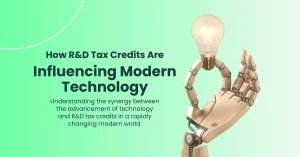Understanding the role of R&D in the construction industry
7 November 2023

In the intricate world of construction, Research and Development (R&D) stands as a cornerstone for transformative progress and innovation. From pioneering new materials to refining building processes, R&D in the construction industry plays a pivotal role in shaping the infrastructure we inhabit. However, awareness of R&D tax credits for construction remains low. Nonetheless, the industry is rife with bustling innovations, outside-of-the-box thinking, and trial-and-error experimentation that are tackling industry challenges head-on. This article delves into the fundamental role of R&D within the construction sector, exploring its significance in fostering groundbreaking advancements, improving efficiency, and steering the industry towards sustainability in an ever-evolving landscape.
What is R&D in the construction industry?
Research and Development (R&D) within the construction industry encompasses the pursuit of innovation, knowledge, and technological advancements to enhance building processes, materials, and structural designs. This takes place in all parts of construction including commercial, residential, retrofitting, and building new. R&D initiatives in construction aim to address challenges such as reducing environmental impact, enhancing structural integrity, streamlining processes, and creating more cost-effective and durable infrastructure. It involves investigating and implementing new approaches, materials, and systems that push the boundaries of conventional construction methods, seeking to introduce novel solutions that lead to better, safer, and more sustainable built environments.
The impact of R&D tax credits on the construction industry
It is vital for businesses to take advantage of the opportunity of R&D tax credits. The financial benefit that is rewarded through successful R&D claims actively supports the longevity of projects, helping businesses take risks and push forward their endeavours without being held back by R&D costs, such as pension contributions, travel, PAYE contributions, and more. It is funding for creativity and if used strategically, R&D can propel the construction industry ahead of expectations. The government encourages innovation which is the core reason for the design of these tax incentives.
How to claim for R&D tax credits?
You need to meet the eligibility criteria to claim. There are two incentives, tax credits for SMEs and the Research and Development Expenditure Credit (RDEC) for larger companies. To qualify for R&D tax credits, your R&D claim must highlight how you achieved, or attempted, to overcome scientific or technical uncertainty through a trial or error approach. As part of your claim, you’ll need to provide documents and evidence of these activities, such as technical reports, financial records, time sheets, and project plans.
The challenges faced in the construction industry
R&D activities solve industry challenges by fostering innovation and developing new solutions that tackle technical uncertainties, pushing the boundaries of conventional methods to enhance efficiency, productivity, and sustainability. Looking specifically at the construction industry’s challenges, R&D projects may focus on tackling the following:
Skills shortages
Difficulty in finding skilled labour, including carpenters, electricians, and engineers, leading to project delays and increased labour costs.
Not embracing technology
Slow adoption of technological advancements such as Building Information Modelling (BIM), drones, and other innovative construction technologies due to resistance to change and limited digital literacy within the industry.
Environmental damage
Meeting stringent environmental regulations, reducing the carbon footprint, and adopting sustainable building practices despite initial higher costs.
Project delays and cost overruns
Challenges in adhering to project timelines and budgets due to unforeseen circumstances, changes in project scope, and supply chain disruptions.
Supply chain disruptions
Fluctuating material costs, shortage of materials, and delayed deliveries, especially exacerbated during global crises, impacting construction schedules and budgets.
Regulatory compliance
Navigating complex and frequently changing regulations, safety standards, and zoning requirements, can add administrative burden and costs to projects.
Risk management and insurance costs
Managing risks associated with safety, liability, and contractual disputes, leading to increased insurance costs and project uncertainties.
Ageing infrastructure
Renovating or replacing ageing infrastructure while managing disruptions and constraints imposed by operating within existing urban environments.
Examples of qualifying R&D activities in construction
The existence of construction challenges provides plenty of opportunities to innovate, improve, and solve. Here are a handful of innovative examples of R&D projects in the construction industry which would make strong claims:
Project efficiency and timeliness
Addressing delays in project completion through the development of innovative scheduling methods, improved project management tools, and more efficient construction techniques.
Sustainability and green building
Developing eco-friendly materials, energy-efficient designs, and sustainable construction methods to reduce the environmental impact of construction projects.
Safety enhancements
Innovating safety protocols, technologies, and equipment to ensure safer working conditions and minimize accidents on construction sites.
Cost reduction and budget management
Exploring new construction materials or methods that can reduce overall project costs, improve cost forecasting, and enhance budget management.
Modular and prefabricated construction
Researching and developing advanced modular and prefabrication techniques to streamline construction processes, reduce waste, and enhance building quality.
Resilience to climate change
Developing construction solutions that account for climate change challenges, such as more resilient infrastructure against extreme weather events or rising sea levels.
Digital transformation and technology integration
Embracing digital technologies like Building Information Modeling (BIM), drones, and augmented reality for improved project planning, design, and execution.
R&D projects within the construction industry aim to address these challenges by fostering innovation, encouraging experimentation, and pushing the boundaries of traditional construction methods to create more efficient, sustainable, and cost-effective solutions.
Summarising R&D in the construction industry
In the construction industry, Research and Development (R&D) fuels innovation, offering financial support and a pathway to overcoming industry challenges. R&D tax credits provide a vital boost, empowering companies to pursue creativity without financial constraints. By embracing R&D credits, construction firms can propel advancements in project efficiency, sustainability, safety, cost reduction, and technological adoption. These initiatives address challenges like skills shortages, environmental impact, and project delays. R&D stands as a beacon, driving progress, offering innovative solutions, and shaping a more resilient and advanced construction landscape.
How Alexander Clifford can elevate your R&D claim to HMRC’s standards
Our expert team has already retrieved over £83 million for our clients and this is down to our in-house compliance processes, meticulously checking each claim to ensure it provides HMRC with everything they need to send out the tax credits. With detailed knowledge about R&D in the construction industry, we’ve built a great reputation with our clients. It’s fantastic to watch in real-time the evolution of the construction industry towards a greener, more productive, and brighter future. To ensure no one misses out on the unmissable opportunity of R&D, we have a No-Win No-Fee policy. You can explore your eligibility easily and if your claim isn’t successful, you won’t incur any costs. Get in touch today to start the process!







